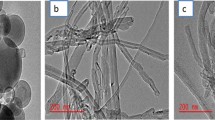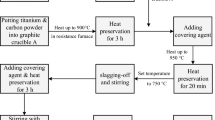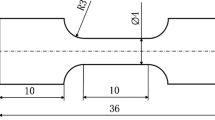Abstract
Electrical power demands are increasing every year, meaning that lightweight electric cable is needed which has high transmission capacity, high thermal resistance and low sag. Tokyo Electric Power Co., Chubu Electric Power Co. and Hitachi Cable Ltd. have been breaking new ground in the field of electric cable through the development of a SiC fiber reinforced aluminum conductor. In this work, the SiC/Al interface reaction during the manufacturing process and the electricity transmission temperature were studied by transmission electron microscopy (TEM), energy dispersive X-ray spectroscopy (EDX) and field emission-Auger electron spectroscopy (FE-AES) for long-term reliability assessment. No reaction products were detected at the SiC/Al interface of elemental wire consisting of 7 SiC/Al preformed wires, indicating that the wire manufacturing process was reliable. An Al4C3 product was detected locally at the SiC/Al interface of the wire which had been thermally treated in molten Al under unfavorable conditions. The activation energy, Q, of Al4C3 growth at the SiC/Al interface was about 190 kJ/mol. In the temperature range of electricity transmission, Al atoms diffused into SiC fiber during heat treatment, and the amount of the diffused Al increased with increasing treatment temperature and holding time. The activation energy of Al diffusion through the SiC/Al interface to SiC fiber was about 78 kJ/mol. Strength deterioration was not induced by Al diffusion into SiC fiber, but strength strongly depended on the formation of Al2SiO5 compound at the SiC/Al interface above 400°C transmission temperatures. Kinetics calculations indicated that the rate of strength deterioration of the composite cable, held at 300°C for 36 years, was about 5%, so that practical use of SiC/Al composite cable should not be far in the future.
Similar content being viewed by others
References
K. Ouchi et al., in Proceedings of National Convention Record I.E.E. Japan (Waseda Univ., Tokyo, (1996) p. 7.1.
J. Sawada et al., in Proceedings of the Seven Annual Conference of Power & Energy Society, IEE of Japan (Osaka Univ., Osaka, (1996) p. 739.
Y. Kagawa and B.-H. Choi, J. Japan Inst. Metals 53 (1989) 339.
Y. Imai, M. Takeda, H. Ichikawa and T. Ishikawa, J. Japan Inst. Light Metals 40 (1990) 202.
M. Kondo, Y. Imai, H. Tezuka and A. Kohyama, ISIJ International 75 (1989) 1463.
J. Tanaka, H. Ichikawa, T. Hayase, K. Okamura and T. Matsuzawa, Prog. Sci. Eng. Compos. 2 (1982) 1407.
S. J. Swindlehurst and I. W. Hall, J. Mater. Sci. 29 (1994) 1075.
A. R. Chapman, S. M. Bleay and V. D. Scott, ibid. 29 (1994) 4523.
H. Liu, U. Madaleno, T. Shinoda, Y. Mishima and T. Suzuki, ibid. 25 (1990) 4247.
H. Tezuka, Y. Imai, M. Kondo and A. Kohyama, ISIJ International 75 (1989) 1470
H.-M. Cheng, B.-L. Zhou, A. Kitahara and K. Kobayashi, J. Mater. Res. 11 (1996) 1284.
K. Matsunaga, S. Ochiai, K. Osamura, Y. Waku and T. Yamamura, J. Japan Inst. Metals 57 (1993) 1035.
P. P. Trzaskama and E. Mccafferty, J. Electrochem. Soc. 130 (1983) 1804.
D. M. Aylor and P. J. Moran, ibid. 132 (1985) 1277.
Y.-C. Park, G.-C. Lee, T. Mihara and K. Date, J. Japan Inst. Metals 57 (1993) 301.
J.-J. Lim and K.-S. Kim, Trans. Korean Soc. Mech. Eng. 17 (1993) 2498.
T. G. Nieh, Metall Trans. A 15 (1984) 139.
N. Tsangarakis, B. O. Andrews and O. C. Cavallar, J. Compos. Mater. 21 (1987) 481.
D. Rouby and H. Osmani, J. Mater. Sci. Lett. 7 (1988) 1154.
C. Badini, J. Mater. Sci. 25 (1990) 2607.
H.-S. Yoon, A. Okura and H. Ichinose, ISIJ International 75 (1989) 1455.
I. H. Khan, Met. Trans. 7A 9 (1976) 1982.
K. Yamada, S. Sekiguchi, K. Hashimoto and T. Ishida, J. Japan Inst. Metals 59 (1995) 15.
S. Towata and S. Yamada, ibid. 47 (1983) 159.
X.-C. Liu and K.-T. Wei, Jinshu Xuebao 24 (1988) B115.
S. L. Coleman, V. D. Scott and B. Mcenaney, J. Mater. Sci. 29 (1994) 2826.
A. H. Carim, Mater. Lett. 12 (1991) 153.
Y. Imai, K. Uemura, H. Ichikawa and T. Ishikawa, J. Japan Inst. Light Metals 40 (1990) 195.
S. D. Peteves, P. Tambuyser and P. Helbach, J. Mater. Sci. 25 (1990) 3765.
S. Yajima, K. Okamura, J. Hayashi and M. Omori, J. Amer. Ceram. Soc. 59 (1976) 3.
Author information
Authors and Affiliations
Rights and permissions
About this article
Cite this article
Yasutomi, Y., Sawada, J., Kikuchi, T. et al. Effects of the SiC/Al interface reaction on fracture behavior of a composite conductor using SiC fiber reinforced aluminum for next generation power equipment. Journal of Materials Science 34, 1583–1593 (1999). https://doi.org/10.1023/A:1004524516143
Issue Date:
DOI: https://doi.org/10.1023/A:1004524516143




